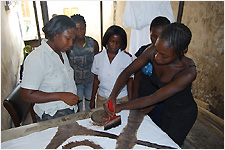Community mapping
Tool 2.4 The mapping tool is a good way for people to learn about a community and helps members of a community to appreciate what they already have.
 A team of people should undertake a mapping exercise ensuring that as many different opinions and perspectives are included. Community members are asked to draw a map of the area. The map can be used to encourage people to talk about their community, its resources, issues and concerns.
A team of people should undertake a mapping exercise ensuring that as many different opinions and perspectives are included. Community members are asked to draw a map of the area. The map can be used to encourage people to talk about their community, its resources, issues and concerns.
You will need:
An Organiser – responsible for paper, pens, lime powder etc, ensuring that all team members are present and all members of the team understand the role they have to play.
A Note Taker – responsible for listing age, names and background information of participants and important issues raised and for transferring a map drawn on the ground to paper if needed.
A Facilitator – responsible for introducing the group, explaining the activity and making it clear not to raise expectations. The facilitator conducts the mapping exercise using open and exploring questions, and makes sure that the team allows the community to own the process. The facilitator ensures that no one dominates the mapping process, and, at the end, sums up the exercise and thanks the group for its participation.
» Salvation Army team members in Latin America have found it helpful to focus on the following three questions when talking to people in the community:
1. What are your hopes/dreams?
2. What are your concerns?
3. How does the community see these concerns/hopes? Are they shared by others?
An Assistant Facilitator – assists the facilitator with the mapping exercise and questioning process. For example: 'What one thing would you like to see change in your community in the next 5 to 10 years?' and uses 'digging deeper' questions to probe more deeply into the issue.
Observers – responsible for noting how the facilitator uses tools and techniques in the mapping exercise (interviewing, questioning etc) and the participation and body language of community members. The observers should also note what goes well and what doesn’t go well about the exercise, and keep track of time.
After the map is completed it is important to debrief and reflect on what has been learnt. The following questions may be helpful:
- What new insights were gained?
- What did we learn about each other?
- What went well and why?
- What didn’t go well and why?
- How did you start discussion? How do you know if this worked?
- Who started the drawing? Why? And what happened next?
- Did the participants seem interested in the map-drawing exercise? How could you tell?
- Did the facilitator sit back at all? At what point and for how long? What happened during this time?
- Out of the whole group, who participated the most and who participated the least? Why?
- What listening methods did the facilitator use? Were they helpful?
- What questioning methods did the facilitator use? Were they helpful?
- Was the map useful to your discussion and how?
- What could we do better next time?
